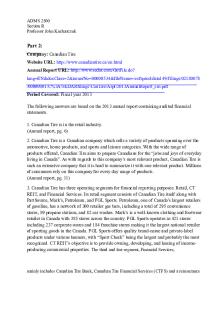Chapter 13 Assignment: Canadian Firm Foreign Market Entry PDF

| Title | Chapter 13 Assignment: Canadian Firm Foreign Market Entry |
|---|---|
| Author | Kimberly Jones |
| Course | International Business |
| Institution | University of Akron |
| Pages | 3 |
| File Size | 37.3 KB |
| File Type | |
| Total Downloads | 78 |
| Total Views | 147 |
Summary
Answers these questions:
A small Canadian firm that has developed valuable new medical products using its unique biotechnology know-how is trying to decide how best to serve the European Union market. Its choices are given below. The cost of investment in manufacturing facilities will be a maj...
Description
Kimberly Jones International Business Chapter 13 Assignment March 24, 2019
Given that a small Canadian firm is looking to become involved in the European market with its new, valuable medical technology, many factors should be considered. The amount of capital that the company has to spend is one of the most important. Some other considerations for the company include exactly which markets they will enter and when. As Europe is made up of many different countries, cultures, languages, and needs, each individual area must be considered before entering into “the European market.” A substitute or similar product may be available in some areas and not in others, or the profit margins could be quite different between that of the Western European markets from the Eastern European markets. Timing should also be considered in that there could be serious first mover disadvantages associated with this expansion such as the cost of promoting a new item, educating the customer, and the massive risk. In terms of scale of entry, there are the options of manufacturing the products at home and hiring a foreign sales agent to handle marketing, manufacturing the products at home and setting up a wholly owned subsidiary in Europe to handle marketing, and entering into an alliance with a large European pharmaceutical firm with the products being manufactured in Europe by the 50-50 joint venture and marketed by the European firm. The first option would be a version of simply exporting, a good option for companies with low amounts of capital to
invest in their expansion. This option becomes less attractive for the company when the high transportation cost, high production cost in Canada, and the strict European rules of pharmaceutical imports/consumer regulations. The hired foreign marketing agent would also be an inherent risk, given that he or she is not truly loyal to the firm nor would be the most efficient way to truly enter all the individual markets of Europe. The next option of manufacturing the products in Canada while also owning a wholly owned subsidiary is much more attractive in this specific case. The company would set up a completely new operation in Europe for marketing while maintaining tight control over the biotechnology at home. The wholly owned subsidiary would allow the company to ultimately acquire a substantial economy of location and scale in the European market. In addition to this, the marketing subsidiary would be in sync with the goals of the rest of the company and there would be no risk of know-how leaving the company. The obvious downside of this is the risk involved for the company. If they hired a marketing agent, any failure would be less consequential to their finances, however any gain would not be as great. The final option of entering into an alliance with a large European pharmaceutical firm with the products being manufactured and marketed by the European firm, should be immediately criticized. This option puts the Canadian firm into an immediate vulnerable position. The nature of the biotechnological know-how should be guarded carefully, a venture like this would give the valuable information to another firm. On top of this, the European firm being much bigger than the Canadian, could easily become a competitor and overpower the other. While there are benefits to consider, like the gained cultural and market knowledge and shared risk, the disadvantages greatly outweigh them.
For this specific company, the first option could be a good starter option, with its greatest benefit being the lack of risk and expended capital. In terms of best long-term decision, the second option is the clear choice. The firm should aim to have a wholly owned subsidiary in Europe to handle marketing while maintaining tight control on the production and know-how in Canada....
Similar Free PDFs

Chapter 9 - Foreign Exchange Market
- 18 Pages

Exam QnA Foreign Exchange market
- 3 Pages

Chapter 13 Listening Assignment
- 8 Pages

Assignment on Canadian Tire
- 5 Pages

Entry requirements (U1 Assignment)
- 11 Pages

Journal Entry Assignment 5
- 2 Pages

Chapter+13 - chapter 13
- 50 Pages
Popular Institutions
- Tinajero National High School - Annex
- Politeknik Caltex Riau
- Yokohama City University
- SGT University
- University of Al-Qadisiyah
- Divine Word College of Vigan
- Techniek College Rotterdam
- Universidade de Santiago
- Universiti Teknologi MARA Cawangan Johor Kampus Pasir Gudang
- Poltekkes Kemenkes Yogyakarta
- Baguio City National High School
- Colegio san marcos
- preparatoria uno
- Centro de Bachillerato Tecnológico Industrial y de Servicios No. 107
- Dalian Maritime University
- Quang Trung Secondary School
- Colegio Tecnológico en Informática
- Corporación Regional de Educación Superior
- Grupo CEDVA
- Dar Al Uloom University
- Centro de Estudios Preuniversitarios de la Universidad Nacional de Ingeniería
- 上智大学
- Aakash International School, Nuna Majara
- San Felipe Neri Catholic School
- Kang Chiao International School - New Taipei City
- Misamis Occidental National High School
- Institución Educativa Escuela Normal Juan Ladrilleros
- Kolehiyo ng Pantukan
- Batanes State College
- Instituto Continental
- Sekolah Menengah Kejuruan Kesehatan Kaltara (Tarakan)
- Colegio de La Inmaculada Concepcion - Cebu








